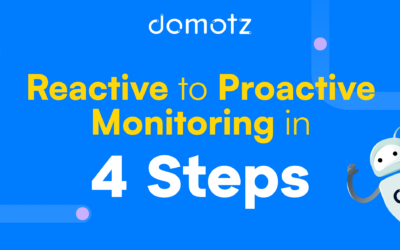What Is Real-time Monitoring?
In short, real-time network monitoring is the process of monitoring all your connected systems in real time. Such monitoring includes instant alerts that allow you to take action and prevent your business from real problems.
Ten Reasons to Adopt Real-time Network Monitoring
#1 Rely on Actionable Alerts
Setting up and receiving alerts plays a crucial role in real-time monitoring. To clarify, alerting is when monitoring tools generate alerts to notify your team of changes in the network you manage. As a result, you can inform your clients or resolve the issue before becomes a real problem.
Remember that you should adopt an alerting system with reliable and actionable alerts. In other words, you should be able to customize the alerts you want to receive. For instance, a comprehensive alert system will promptly tell you if a device goes offline, allowing you to examine and address the problem before it affects your operations. Likewise, if there are performance concerns, like excessive latency or insufficient bandwidth, you will be notified so that you can promptly resolve these issues.
A Domotz tip: If you adopt Domotz, you can rely on an alerting system that offers comprehensive alerting variables, customization, security, and sensor alerts. What’s more, we are integrated with 3rd party systems.
#2 A Proactive Issue Detection and Time to Resolution
This is one of the most important reasons for many. The reason? If you can rely on proactive issue detection, you don’t need to check systems and devices constantly. Instead, your proactive monitoring systems do it for you.
Real-time monitoring tools help you detect potential issues before they become real problems for your clients.
A Domotz tip: Domotz offers a perimeter security scan that will proactively monitor your network for open ports on devices potentially causing vulnerabilities. In other words, Domotz automatically scans your network for security vulnerabilities and sends you real-time alerts every time a new device joins the network.
Read more about network security scans and new device security events.
#3 Enhanced Security
Of course, security is one of the main concerns for businesses of all sizes. Relying on real-time network monitoring improves security. Proactive monitoring tools can detect anomalies and send alerts so you can take appropriate action.
This not only safeguards your business but also helps maintain the trust of your customers.
A Domotz tip: In addition to alerts about new devices joining the network, Domotz offers SSO/SAML authentication and Two-factor authentication.
Read more on network performance and security features by Domotz.
#4 Improved Network Performance
It’s no secret that a well-performing network is crucial to any business. After all, efficient network monitoring is critical to improving productivity.
Real-time monitoring provides insights into crucial network performance metrics. For example, you can monitor bandwidth usage, latency, packet loss, and more.
A Domotz tip: Use the network performance monitoring and reporting feature to ensure smooth network operation, minimize downtime, and enhance overall network performance. The feature includes speed tests, route analyses, downtime, and more.
#5 Efficient Troubleshooting
Real-time network monitoring helps you swiftly identify and troubleshoot network issues. It provides detailed, actionable data that helps identify the exact cause of network problems, such as IP conflicts or DHCP misconfigurations.
A Domotz tip: Use the network troubleshooting feature to gain comprehensive visibility into your network’s health. With Domotz, you will effortlessly assess performance, monitor DHCP requests, identify IP address conflicts, analyze buffer bloat, and more.
#6 Resource Optimization
Real-time monitoring can help you optimize resources in many ways. In other words, it can identify ways to automate routine tasks. For example, you can use your network monitoring software to automatically close tickets when certain events occur.
A Domotz tip: Find the Domotz powerful integrations.
#7 Cost Efficiency
Sometimes, the price of putting in place a real-time monitoring system may appear high. However, you may consider this cost to be a long-term savings in your account. In other words, you and your clients can save on repairs and lost income.
Additionally, as mentioned above, real-time monitoring promotes resource optimization, which can, therefore, reduce operating costs. Rapid problem-solving and identification also reduce the need for emergency IT support, which further lowers costs.
A Domotz tip: Get simple, straightforward, and transparent pricing. Check our pricing options.
#8 Scalability and Flexibility
Often, your network’s complexity increases as your business grows. As a result, you must monitor more apps, systems, devices, and people. What’s more, you need to do it without sacrificing efficiency.
A Domotz tip: Use Domotz to manage the complexity with ease. Our software supports various devices and systems, including servers, network switches, Wi-Fi access points, IP security cameras, power management devices, audio/video systems, and more. This extensive compatibility ensures that as your network grows, Domotz can scale with it, accommodating new devices and technologies seamlessly.
#9 Improved Customer Experience
It should come as no surprise that network performance can frequently immediately affect the user experience. Service outages, security breaches, and slow load times can annoy and drive clients away.
A Domotz tip: Real-time network monitoring provided by Domotz helps ensure that your digital services are always available and performing at their best.
#10 Improved Decision Making
Effective decision-making is a must if you run an IT business. Relating to a real-time network monitoring tool will help you make better decisions.
A Domotz tip: Domotz provides a wide range of features. Use them to improve your decision-making process.
How To Set Up A Real-time Monitoring System?
Implementing real-time monitoring can be a real challenge. Thus, you may consider defining key steps to implement it:
- Define your monitoring goals: Of course, your monitoring goals may change. However, it’s important to have clear goals of what to monitor and why.
- Adopt the right tools: Identify the tools that your business needs to satisfy your clients. You might consider a ticketing system, a PSA tool, or a network monitoring system.
- Deploy, connect , and configure: Install and configure the systems you need. Deploy collectors and set up scripts and SNMP sensors across your network infrastructure.
- Configure alerts: Set up your alerts for critical network and device events and implement proactive monitoring.
- Fine-tune your systems: Regularly check your monitoring thresholds, alerts, and reports to tweak the output best to suit your business needs. Build more comprehensive and customized monitoring dashboards to streamline your workflows with the needed information.
Read more about network monitoring best practices.
Examples of Problems that Real-time Monitoring Can Help Resolve
Real-time monitoring is a powerful tool that can help resolve a variety of network-related issues.
Here are some examples of problems that real-time monitoring can address:
- Network Outages: Real-time monitoring can detect when a network goes down and immediately alert the relevant personnel. This allows for quick response and minimizes downtime.
- Device Failures: If a critical device such as a router, switch, or server fails, real-time monitoring can identify the failure and send alerts, enabling swift action to replace or repair the device.
- Security Breaches: Real-time monitoring can detect unusual activity that may indicate a security breach, such as unexpected spikes in traffic or unauthorized access attempts. Immediate alerts can help in taking quick action to mitigate the threat.
By addressing these problems promptly, real-time monitoring helps maintain network stability, security, and performance, ensuring a smooth and efficient operation.
Bottom Line
In an increasingly connected world, maintaining a healthy, secure, and efficient network cannot be overstated. Real-time network monitoring offers businesses a powerful tool to proactively manage their networks, enhance security, optimize performance, and reduce costs. By investing in a robust real-time monitoring solution, your business can stay ahead of potential issues, protect its data, and provide a better experience for employees and customers.
Are you ready to take your network management to the next level? Explore how Domotz’s real-time network monitoring solutions can help your business thrive in today’s digital landscape.
In summary, real-time network monitoring equips MSPs with the tools and insights to maintain high network performance, enhance security, optimize resources, and deliver superior client service.
Further reading:



